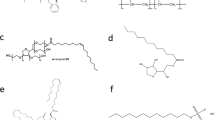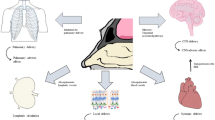Abstract
Purpose
Tetramethylpyrazine-loaded poloxamer hydrogel materials were studied to achieve the controlled release of tetramethylpyrazine.
Methods
First, hydrogels having different concentrations of poloxamer 407 and poloxamer 188 were prepared. The gelling temperature and viscosity were measured. Second, we investigated the tetramethylpyrazine release rate from the thermosensitive poloxamer hydrogel materials in vitro and ex vivo. Finally, further study of the pharmacological efficacy of the tetramethylpyrazine-loaded thermosensitive poloxamer hydrogel materials was also investigated in vivo.
Results
The in vitro, ex vivo and in vivo experimental results showed that the tetramethylpyrazine-loaded poloxamer hydrogel with the appropriate gelling temperature, good adhesion and easy preparation controlled the release of tetramethylpyrazine.
Conclusions
The hydrogel with the suitable nasal temperature and a satisfactory adhesion was selected. The relevant tests were carried out, including the determination of the concentration of drugs in the brain homogenate and the anti-inflammatory test after different modes of administration. So the poloxamer hydrogel was a novel carrier to deliver TMP to pass across the blood brain barrier via nasal administration.












Similar content being viewed by others
References
Chinese Pharmacopoeia Commission. Pharmacopoeia of The People’s Republic of China Fouth. (2015) 530–531.
Chinese Pharmacopoeia Commission. Pharmacopoeia of The People’s Republic of China Fouth. (2015) 531–532.
Chinese Pharmacopoeia Commission. Pharmacopoeia of The People’s Republic of China Second. (2015) 876–877.
Ji XX, Song XL, Qian W, Yu XL, Zhu JY. Effects and mechanism of action of ligustrazine on isoprenalineinduced cardiomyocyte hypertrophy. Cell Biochem Biophys. 2014;70:1513–8.
Sheu JR, Hsiao G, Lee YM, Mao HY. Antithrombotic effects of tetramethylpyrazine in in vivo experiments. Int J Hematol. 2001;73:393:398.
Chen L, Liu T, Wang Q, Liu J. Anti-inflammatory effect of combined tetramethylpyrazine, resveratrol and curcumin in vivo. BMC Complement Altern Med. 2017;17:233.
Yang DS, Wang LZ, Li JG, Guo YQ. Study on therapeutic effect of tetramethylpyrazine on hypoxic-ischemic encephalopathy of newborn infants. Chinese Journal of Integrated Traditional and Western Medicine. 2001;7:126–7.
Chen HY, Xu DP, Tan GL, Cai W, Zhang GX, Cui W, et al. A potent multi-functional neuroprotective derivative of tetramethylpyrazine. J Mol Neurosci. 2015;56:977–87.
Chen SY, Hsiao G, Hwang HR, Cheng PY, Lee YM. Tetramethylpyrazine induces heme oxygenase-1 expression and attenuates myocardial ischemia-reperfusion injury in rats. J Biomed Sci. 2006;13:731–40.
L.N. Lin, W.T. Wang, Z.J. Xu, Clinical study on ligustrazine in treating myocardial ischemia and reperfusion injury. Chinese Journal of Integrated Traditional and Western Medicine 17 (1997) 261–263.
Li S, Huang P, Liu C. Effect of ligustrazine injection on vascular endothelial cell of the patients with arteriosclerosis obliterans. Chinese Journal of Integrated Traditional and Western Medicine. 2000;20:412–4.
Peng W, Duan SF. Effects of ligustrazine controlled release capsule in chronic pulmonary heart disease. J Tongji Med Univ. 1991;11:101–5.
Feng J, Li FZ, Zha YM, Feng YR, Abe Y. Brain pharmacokinetics of tetramethylpyrazine after intranasal and intravenous administration in awake rats. Int J Pharm. 2009;375:55–60.
Xia HM, Cheng ZQ, Cheng YF, Xu YX. Investigating the passage of tetramethylpyrazine-loaded liposomes across blood-brain barrier models in vitro and ex vivo. Mater Sci Eng C. 2016;69:1010–7.
Dahlin M, Bergman U, Jansson B, Björk E, Brittebo E. Transfer of dopamine in the olfactory pathway following nasal administration in Mice. Pharm Res. 2000;17:737–42.
Saraiva C, Praça C, Ferreira R, Santos T, Ferreira L, Bernardino L. Nanoparticle-mediated brain drug delivery: overcoming blood–brain barrier to treat neurodegenerative diseases. J Control Release. 2016;235:34–47.
Wolburg H, Lippoldt A. Tight junctions of the blood–brain barrier: development, composition and regulation. Vasc Pharmacol. 2002;38:323–37.
Huber JD, Witt KA, Hom S, Egleton RD, Mark KS, Davis TP. Inflammatory pain alters blood–brain barrier permeability and tight junctional protein expression. Am J Physiol Heart Circ Physiol. 2001;280:H1241–8.
Kim TH, Lee SH, Moon JH, Lee HM, Lee SH, Jung HH. Distributional characteristics of lymphatic vessels in normal human nasal mucosa and sinus mucosa. Cell Tissue Res. 2007;327:493–8.
Borodina TN, Trushina DB, Marchenko IV, Bukreeva TV. Calcium carbonate-based mucoadhesive microcontainers for intranasal delivery of drugs bypassing the blood–brain barrier. BioNanoScience. 2016;6:261–8.
Potschka H. Targeting the brain – surmounting or bypassing the blood–brain barrier. Handb Exp Pharmacol. 2010;197:411–31.
Bonta IL, Noordhoek J. Anti-inflammatory mechanism of inflamed-tissue factor. Agents Actions. 1973;3:348–56.
Simon RA. Adverse respiratory reactions to aspirin and nonsteroidal anti-inflammatory drugs. Curr Allergy Asthma Rep. 2004;4:17–24.
Ramachandran R, Bhatt K, Jansenolesen I, Olesen J. Nitric oxide synthase, calcitonin gene-related peptide and inflammatory mechanisms are involved in GTN induced neuronal activation. Cephalalgia. 2013;14:P217.
Rödel F, Hofmann D, Auer J, et al. The anti-inflammatory effect of low-dose radiation therapy involves a diminished CCL20 chemokine expression and granulocyte/endothelial cell adhesion. Strahlenther Onkol. 2008;184:41–7.
Abumaree MH, Al Jumah MA, Kalionis B, et al. Human placental mesenchymal stem cells (pMSCs) play a role as immune suppressive cells by shifting macrophage differentiation from inflammatory M1 to anti-inflammatory M2 macrophages. Stem Cell Rev Rep. 2013;9:620–41.
Halici Z, Suleyman H, Cadirci E. Effects of calcium channel blockers on hyaluronidase-induced capillary vascular permeability. Arch Pharm Res. 2008;31:891–9.
Tanaka T, Fillmore D, Sun ST, Nishio I, Swislow G, Shah A. Phase transition in ionic gels. Phys Rev Lett. 1980;45:1636–9.
Lin CC, Metters AT. Hydrogels in controlled release formulations: network design and mathematical modeling. Adv Drug Deliv Rev. 2006;58:1379–408.
Jin L, Lu P, You HH, Chen QA, Dong J. Vitamin B12 diffusion and binding in crosslinked poly(acrylic acid)s and poly(acrylic acid-co-N-vinyl pyrrolidinone)s. Int J Pharm. 2009;371:82–8.
Lee ALZ, Ng VWL, Gao S, Hedrick JL, Yang YY. Injectable hydrogels from triblock copolymers of VitaminE-functionalized polycarbonate and poly(ethylene glycol) for subcutaneous delivery of antibodies for Cancer therapy. Adv Funct Mater. 2014;24:1538–50.
Wang Y, Chen S, Qiu L, Wang K, Wang H, George PS, et al. Graphene-directed supramolecular assembly of multifunctional polymer hydrogel membranes. Adv Funct Mater. 2015;25:126–33.
Wei Z, Yang JH, Liu ZQ, Xu F, Zhou JX, Zrínyi M, et al. Novel biocompatible polysaccharide-based self-healing hydrogel. Adv Funct Mater. 2015;25:1352–9.
Du YK, Shinde UP, Yeon B, Jeong B. Recent progress of in situ formed gels for biomedical applications. Prog Polym Sci. 2013;38:672–701.
Bakarich SE, Panhuis MIH, Beirne S, Wallace GG, Spinks GM. Extrusion printing of ionic–covalent entanglement hydrogels with high toughness. J Mater Chem B. 2013;1:4939–46.
Markus F, Dreher F, Laschat S, Baudis S, Tovar GEM, Southan A. Physically and chemically gelling hydrogel formulations based on poly(ethylene glycol) diacrylate and Poloxamer 407. Polymer. 2017;108:21–8.
Boonlai W, Tantishaiyakul V, Hirun N, Phaisan S, Uma T. The effect of the preservative methylparaben on the thermoresponsive gelation behavior of aqueous solutions of poloxamer 407. J Mol Liq. 2017;240:622–9.
Al Khateb K, Ozhmukhametova EK, Mussin MN, Seilkhanov SK, Rakhypbekov TK, Lau WM, et al. In situ gelling systems based on Pluronic F127/Pluronic F68 formulations for ocular drug delivery. Int J Pharm. 2016;502:70–9.
Kjøniksen AL, Calejo MT, Zhu K, Nyström B, Sande SA. Stabilization of pluronic gels in the presence of different polysaccharides. J Appl Polym Sci. 2014;131:40465.
Matanović MR, Kristl J, Grabnar PA. Thermoresponsive polymers: insights into decisive hydrogel characteristics, mechanisms of gelation, and promising biomedical applications. Int J Pharm. 2014;472:262–75.
Kaizu K, Alexandridis P. Micellization of polyoxyethylene–polyoxypropylene block copolymers in aqueous polyol solutions. J Mol Liq. 2015;210:20–8.
Sharma PK, Reilly MJ, Jones DN, Robinson PM, Bhatia SR. The effect of pharmaceuticals on the nanoscale structure of PEO–PPO–PEO micelles. Colloid Surface B. 2008;61:53–60.
Sharma PK, Reilly MJ, Bhatia SK, Sakhitab N, Archambault JD, Bhatia SR. Effect of pharmaceuticals on thermoreversible gelation of PEO–PPO–PEO copolymers. Colloid Surface B. 2008;63:229–35.
Boucenna I, Royon L, Colinart P. Effect of laponite clay particles on thermal and rheological properties of Pluronic triblock copolymer. J Therm Anal Calorim. 2009;98:119–23.
Liu S, Bao H, Li L. Role of PPO–PEO–PPO triblock copolymers in phase transitions of a PEO–PPO–PEO triblock copolymer in aqueous solution. Eur Polym J. 2015;71:423–39.
S.C.R. Gandra, The preparation and characterization of poloxamer-based temperature-sensitive hydrogels for topical, Dissertations Theses - Gradwork, 2013.
Lau BK, Wang Q, Sun W, Li L. Micellization to gelation of a triblock copolymer in water: thermoreversibility and scaling. J Polym Sci B Polym Phys. 2004;42:2014–25.
ACKNOWLEDGMENTS AND DISCLOSURES
This project was financially supported by the Natural Science Foundation of Anhui Province of China (1608085MH227), the 2017 Anhui University of Chinese Medicine annual innovation training program for College Students (2017171, 2017142), the Natural Science Fund of Anhui University of Chinese Medicine (2010zr004A), the Kangyuan Fund (KYCX201001) and the Anhui province science and technology special fund project (13Z04013), the Natural Science Foundation (61573615). The authors report no declarations of interest. The authors alone are responsible for the content.
Author information
Authors and Affiliations
Corresponding author
Additional information
Publisher’s Note
Springer Nature remains neutral with regard to jurisdictional claims in published maps and institutional affiliations.
Hongmei Xia and Hongliu Jin should be co-first authors
Rights and permissions
About this article
Cite this article
Xia, H., Jin, H., Cheng, Y. et al. The Controlled Release and Anti-Inflammatory Activity of a Tetramethylpyrazine-Loaded Thermosensitive Poloxamer Hydrogel. Pharm Res 36, 52 (2019). https://doi.org/10.1007/s11095-019-2580-0
Received:
Accepted:
Published:
DOI: https://doi.org/10.1007/s11095-019-2580-0




